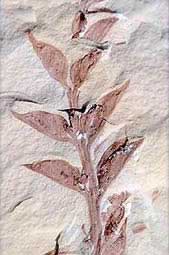Fresh bunch of old flowers

The pick of the new group of flowering plants. <br>© Science <br>
Fossil plants form new branch in flower family tree.
Fossils recently plucked from rocks in China are the first representatives of a hitherto unknown group of flowering plants, say their discoverers Ge Sun of Jilin University and colleagues1.
They also add to growing evidence that flowering plants, which now dominate the land, originally emerged from the water.
The researchers call the group Archaefructaceae. Its members probably flourished in lakes and ponds about 125 million years ago while dinosaurs walked the Earth. They appear to have grown like waterlilies and looked like a cross between ferns and seaweed, having no petals or sepals.
The group is more closely related to the flowering plants, or angiosperms, than to the palm-like cycads, ginkgo and other ancient flora also alive at the time. But the Archaefructaceae are no missing link in plant evolution. Rather, they are an evolutionary dead end – the plants have no known descendants.
The fossils are of two species; Sun’s team names them Archaefructus sinensis and Archaefructus lianogensis. They are exquisitely preserved, giving a detailed picture of Archaefructus’ life history.
The feathery leaves are on long stalks, which are shorter towards the top of the plants’ stems. The stems seem too thin to have stood upright, suggesting that Archaefructus was aquatic, and swellings at the base of the leaves may have given the plants added buoyancy.
The flowers probably developed above the water, as their pollen seems best suited to wind or insect dispersal: the pollen-producing anthers reached maturity before the females carpels to avoid self fertilization.
References
- Sun, G. et al. Archaefructaceae, a new basal angiosperm family. Science, 296, 899 – 904, (2002).
Media Contact
All latest news from the category: Life Sciences and Chemistry
Articles and reports from the Life Sciences and chemistry area deal with applied and basic research into modern biology, chemistry and human medicine.
Valuable information can be found on a range of life sciences fields including bacteriology, biochemistry, bionics, bioinformatics, biophysics, biotechnology, genetics, geobotany, human biology, marine biology, microbiology, molecular biology, cellular biology, zoology, bioinorganic chemistry, microchemistry and environmental chemistry.
Newest articles

“Nanostitches” enable lighter and tougher composite materials
In research that may lead to next-generation airplanes and spacecraft, MIT engineers used carbon nanotubes to prevent cracking in multilayered composites. To save on fuel and reduce aircraft emissions, engineers…

Trash to treasure
Researchers turn metal waste into catalyst for hydrogen. Scientists have found a way to transform metal waste into a highly efficient catalyst to make hydrogen from water, a discovery that…

Real-time detection of infectious disease viruses
… by searching for molecular fingerprinting. A research team consisting of Professor Kyoung-Duck Park and Taeyoung Moon and Huitae Joo, PhD candidates, from the Department of Physics at Pohang University…





















